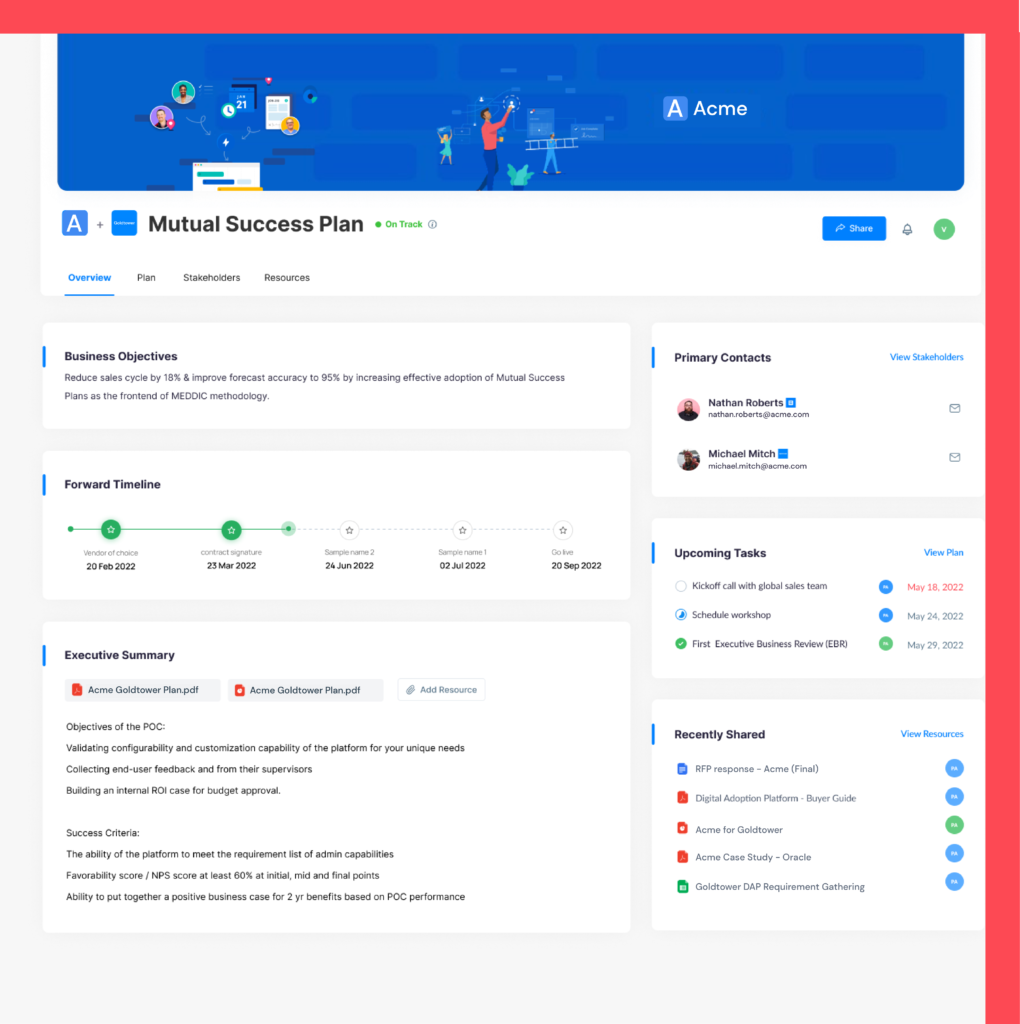 BACK TO BLOG
BACK TO BLOG
Everything that you need to know about Mutual Action Plans

 BACK TO BLOG
BACK TO BLOG

We’ve been saying it for a while now.
We’ll say it again…
Modern buyers are evolving, and so are their preferences for buying.
They want to purchase products on their terms and drive their conclusions with absolute autonomy - with or without talking to the salesperson. This new breed of “sales-proof buyers” want to run their buying journey themselves, seeking value to be demonstrated clearly at each stage, withholding any “sure thing” until a deal is closed. Unfortunately, countless sales organizations are still focused on streamlining their internal sales processes, resulting in overwhelmed buyers losing trust in their process.
According to Gartner, 77% of buyers’ latest purchases are described as either complex or difficult.
As a seller, you now need to create exceptional buyer experiences today - visibility, collaboration, and drive long-term commitments that enhance your buyer's journey. What if we tell you that there’s a much easier way to align with your stakeholders, drive accountability and track your deal's progress?
Well, you’re in complete luck, for there are - the Mutual Action Plans!
A mutual action plan allows your sales team to collaborate, track progress and align with your buyers at each deal stage more effectively. These plans make your sales process buyer-centric - instead of presenting your sales process to the buyers, you’re co-creating the process based on your buyer’s needs, milestones, and desired outcomes.
A Mutual action plan is a living document between your sales team and the buyers that all parties use to define exactly what needs to happen by when for the deal to close and for the customer to get to their first value. The shared document becomes the foundation of business relationships; businesses come together to align and measure the actual value creation.
Here’s how mutual action plans streamline your sales workflow.
B2B buying is a multi-step alignment process between the vendors and buyers. Deals can slip if any steps are missed or left unidentified. A poorly managed process can create chaos in the timeline and agenda items within the deal.
A mutual action plan simplifies the process by delivering an integrated buyer experience by ensuring no information slips through the cracks or misses within the process.
Mutual action plans are co-developed with the champion and continuously reviewed throughout the relationship to ensure that both parties always direct their efforts in the joint pursuit of buyer outcomes and make necessary course corrections in cases of any deviation. These plans highlight total days off schedule, as well as which milestones or stakeholders are causing a delay.
Gartner research suggests that a typical buying group for B2B SaaS companies involves six to ten decision-makers. Often, a new stakeholder wants to join the process towards the end of the evaluation, or the procurement might want to stall the purchase to force an additional discount. Such stakeholders may have unique expectations and preferences that your sales reps should meet to close the loop. Additionally, they’d also want to know the current stage of the deal and put forth their suggestions to minimize the potential slowdown of the deal.
Failing to identify and engage with the stakeholders is one main reason why deals stall completely.
For more on the multiple types of buyers, read this blog.
The intricacies of the process call for your salesperson to accurately and consistently document all relevant business buyer information, like notes on interactions, customer goals, and any common questions they may have.
The mutual action plan platform creates a single shared source of truth with everything in one place- what steps to follow, stakeholder maps, executive summary, files, and contact information- driving smooth exchanges with minimal downtime in the process.
A Gartner study reveals that a typical buying group for a B2B solution involves 6 to 10 decision-makers, each with their own four or five pieces of information they’ve gathered on their own.
Furthermore, your champion has to answer countless questions and sell on your behalf to several stakeholders your sales team may never meet. Needless to say, bringing consensus among conflicting decision-makers is nearly impossible if your champion buyer can articulate the value of your solution, is aware of the process, or doesn’t have the right resources at the right time.
The mutual action plan platform offers a shared space for your champions to onboard new stakeholders or decision-makers into the process through a shared summary, relevant content, case studies explaining use cases, implementation requirements, and more.

The comprehensive view of the vendor-buyer relationship bridges understanding between all parties accountable and focuses on the goals, action plans, and evaluation measures necessary to achieve envisioned outcomes.
Let’s understand a few implications of a MAP that can make a difference:
Imagine toiling hard to win this enterprise customer for the last six months. Just when everything’s falling into place, your champion gives you a green flag, and you too get “happy ears” and call the deal “commit” for the quarter. Yet, in the last few weeks of the quarter, it slips through the crack instead of hitting your most significant commit.
The most common reason? With limited visibility of the buyer's internal actions or stakeholders in the journey, diagnosing risks in the deal becomes hard, leading to inaccurate deal flow, and ultimately resulting in the deal slipping or altogether going to closed lost.
A mutual Success plan makes the buying process go as planned, from plan development to implementation. It ensures things go as planned by allowing stakeholders at both ends of the bargain to view the timeline, delegate tasks, and ensure the deal is anchored on time.
When you know the information of which deals are in play and dud gives you a headspace of spending time and resources timely.
As per Gartner's research, 83% of the buying journey happens without the buyer talking to any vendor salesperson. How can we rely exclusively on the seller to “commit” the deal to a forecast? One might argue that the most significant deals still are sales driven. Still, the dynamics are changing quickly, and the need to capture the buyer intent into the forecasting process has to go beyond call recordings and emails.
A mutual action plan will help you understand and scan efforts to finish the deal, whether a deal is likely to close or not. If the buyer fulfills each step's commitments, they signal great intent, continuing the momentum of your sales team. Furthermore, the plan will also help you necessitate steps to refine your current sales approach and fix the pipeline leakage, influencing an uptick in your revenue flow.

Slogging hours in evaluation, contract negotiations, and due diligence to onboard a new customer? It’s in your salesperson’s best interest to monitor whether your current practices align with delivering buyer value or not. Here’s how a mutual action plan accelerates your sales methodology and process.

While a mutual action plan empowers your sales team by creating a buyer-focused process, these plans are often abandoned right after the contract is signed, fostering decreased credibility and low engagement during future upsells. Your team requires a smooth interface that drives new opportunities forward in complex sales transactions and fits like a glove within your sales workflow.
Mutual success plans are co-created with the buyers and proactively measured throughout the buying process to ensure that both parties emphasize their energy to the buyer outcomes and make necessary course corrections in case of any deviation.
Mutual success plans nail down in
We’ve arrived at a pivotal moment where business buyers independently drive their journey. When buyers choose to do business with a supplier, they have specific outcomes in mind. It’s up to both sides to work together, collaborate around these outcomes and build a long-lasting B2B relationships.
